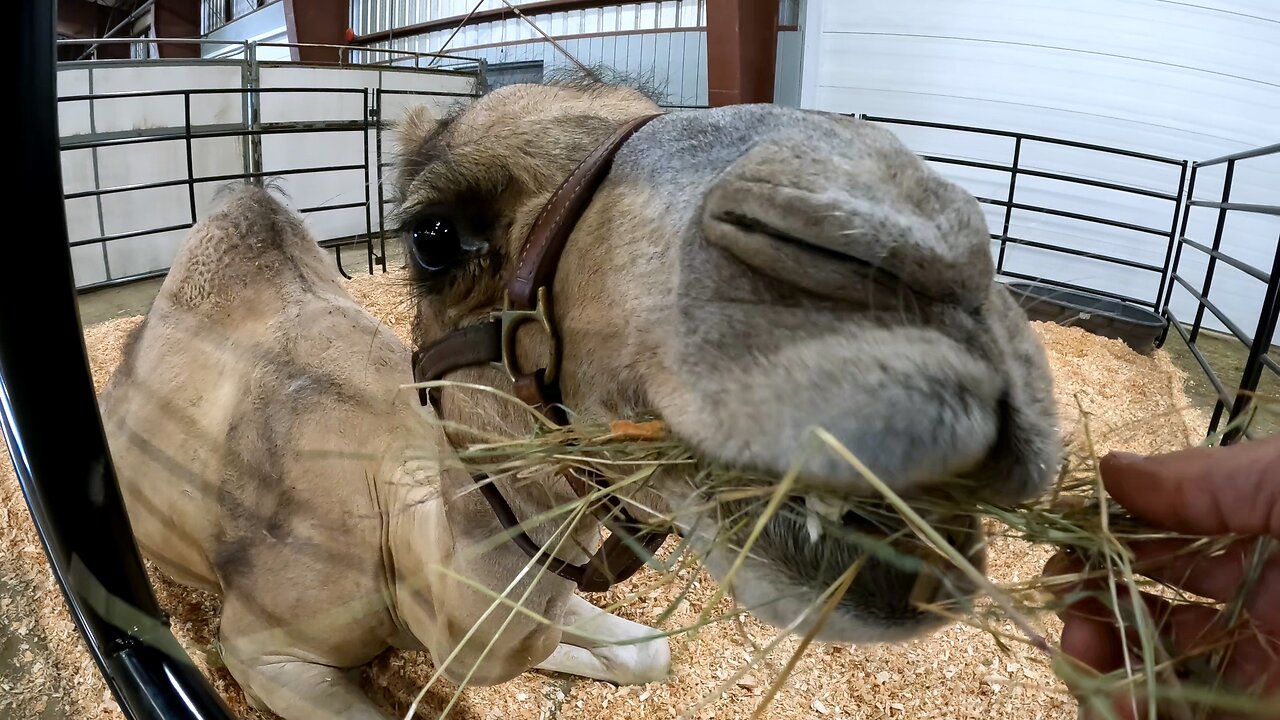Premium Only Content

Very chill camel enjoys a tasty snack
This camel is completely relaxed as he spends the day at a fair in Chilliwack, British Columbia. He's very comfortable with people and he happily allows anyone to pet him and scratch his ears. He'll also happily take a handful of fresh, green hay. He munches contentedly as the people passing by stop to get a close look.
Camels are sturdy mammals known for their distinctive physical characteristics, which enable them to thrive in harsh desert environments.
Camels are large, with adult camels standing about 6 to 7 feet (1.8 to 2.1 meters) tall at the shoulder. They can weigh between 880 to 1,320 pounds (400 to 600 kg).
One of the most distinguishing features is the hump on their back. There are two main species of camels. A dromedary (Arabian) Camel has one hump. A Bactrian camel has two humps. A camel's humps store fat, which can be converted into energy and water when food is scarce.
Camels have large, tough mouths that are well-suited for eating thorny desert vegetation. They have slit-like nostrils that can close to protect against sand and dust. Their eyes are large, with long eyelashes that help keep sand out, and a third eyelid (nictitating membrane) that provides additional protection. Camels have long, powerful legs, which help them walk long distances and carry heavy loads. Their broad, flat feet are specially adapted for walking on sand, with tough, leathery pads that prevent sinking. Camels have thick fur that helps insulate them from both the heat and cold. In the summer, they shed much of this fur to keep cool.
Their coat color ranges from light brown to beige, providing natural camouflage in desert environments. Camels are highly adapted to conserve water. They can drink large amounts of water quickly (up to 40 gallons in one go) and can survive for long periods without drinking.
Camels can tolerate body temperature fluctuations that would be fatal to most other animals, which helps them avoid sweating and thus conserve water.
These characteristics make camels well-suited to life in arid and semi-arid regions, where they have been used by humans for transportation, food, and other resources for thousands of years.
-
 1:55
1:55
WildCreatures
8 days ago $0.93 earnedDolphins and Whale Shark at the same Time Make an Unforgettable Scuba Encounter
2.91K1 -
 LIVE
LIVE
United Fight League
5 hours agoPAUL vs TYSON watch party w/ Rampage Jackson and Harrison Rogers
4,505 watching -
 1:24:47
1:24:47
Kim Iversen
5 hours agoMafia Tactics: A Private Equity Firm Forced Her Into An Abortion To Retaliate Against Her Speaking Up.
27.7K14 -
 2:36:29
2:36:29
Fresh and Fit
4 hours agoCall-In Show
59.7K18 -
 4:08:29
4:08:29
Nerdrotic
7 hours ago $47.77 earnedHollywood in PANIC! Woke Celebrity Meltdown, Penguin Finale CRUSHES! | Friday Night Tights #328
125K26 -
 1:41:22
1:41:22
The Officer Tatum
2 hours agoLIVE: Trump NOMINATES Karoline Leavitt, Whoopi "SMOLLETT" EXPOSED, & MORE | Officer Tatum Show EP 8
14.5K12 -
 30:25
30:25
Glenn Greenwald
4 hours agoGlenn Takes Your Questions Post-Election On The Trump Admin & More
80.2K34 -
 1:26:23
1:26:23
vivafrei
7 hours agoChinese and Indian INFILTRATION in Canadian Government? Live with David Krayden! Viva Frei Live
99.1K40 -
 52:17
52:17
Candace Show Podcast
7 hours agoFight Night! Me VS Marc Lamont Hill On Transgenderism | Candace Ep 104
120K237 -
 1:12
1:12
Mike Tyson
7 hours ago $23.91 earnedIt's a war.
99.5K35